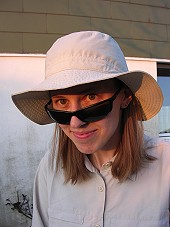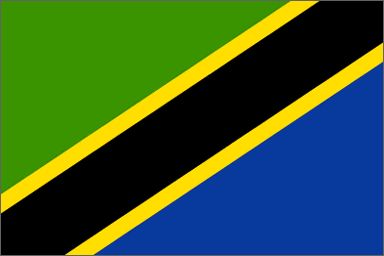Saturday, June 5th & Sunday 6th, 2004 Safari Days III & IV (Serengeti II & III)
On both days, we left the campsite shortly before 6 am, just in time to catch the sunrise, and started our game drives. Serengeti comes from the word “siringet” which in the Maasai language means a great open space, a place where the land goes on forever. They couldn’t have chosen a better name for this area which sprawls across 14,763 sq km. Here you can get a glimpse of what much of East Africa must have looked like in the days before the ‘great white hunters’. The seemingly endless and almost treeless Serengeti plains are home to literally millions of hoofed animals. They’re constantly on the move in search of grassland and are watched and preyed upon by a varied parade of predators.
Some facts about Serengeti, taken from www.serengeti.org, where you can check for more info about this unique piece of earth:
“The Serengeti ecosystem is one of the oldest on earth. The essential features of climate, vegetation and fauna have barely changed in the past million years. Some patterns of life, death, adaptation and migration are as old as the plains themselves. It is the migration for which Serengeti is perhaps most famous. Over a million wildebeest and about 20,000 zebras flow south from the northern hills to the southern plains for the short rains every October and November, and then swirl west and north after the long rains in April, May and June. So strong is the ancient instinct to move that no drought, gorge or crocodile infested river can hold them back.
The wildebeest (also known as gnus) are one of the most important pieces in the Serengeti ecosystem puzzle. Their migration is as old as the history of mankind. For many millenniums the wildebeest followed the rains and used the Serengeti ecosystem with its mosaic of grassland and savannas to their advantage. Everyone who has a chance to see the nearly two million animals on the move has been touched by the magic of this place. Even so the wildebeest looks a bit like a clown and, according to an African legend, has been put together by God using the left over spare parts, the animal is superbly fit for its migration lifestyle.
The wildebeest spent the rainy season from December to June in the volcanic open plains below Ngorongoro Crater where the grass growth is most productive and nutrient contents high. It is here that the calves are born. Calving season is short and the predators cannot make a dent in the new-borns with such a sudden surge of food. When the monsoon rains stop in June, the plains dry out and the wildebeest move west towards Lake Victoria in search of pasture and rains. The plains become harsh and dry semi-desert in which no wildebeest could survive. Only through migration can the wildebeest and zebra use the widespread resources of the ecosystem and build up such large numbers. Following the rainfalls the migration moves on to the north, into the Masai Mara, where the rift wall catches the last rains even in the middle of the dry season. With the onset of the monsoon rains in December the wildebeest move back into the lush Serengeti plains.”
Well, you read it: In terms of timing, we were incredibly lucky and caught the beginning of the migration just after the main rain season. Jerry told us that a week ago he had been in the same park area and had a hard time spotting any animals at all. Well, what can I say? We saw them all: lions, cheetahs, zebras, impalas and gazelles, various birds, hyenas, vultures, jackals, baboons, hippos, elephants and a crocodile. We even spotted a leopard hanging in the tree with its prey (which was identified as an unlucky gnu). But above all others, we saw wildebeest – thousands and thousands of wildebeest who have a starring role in the amazing annual migration.
I can hardly describe the view of these funny looking creatures, trotting along their migrations trails. Just imagine how the great American plains looked like when they were still ruled by big buffalo herds instead of white cowboys. Now replace the buffaloes by wildebeest and you might get pretty close to what we saw in Serengeti. There were thousands of them, all on the move as if magically pulled into a certain direction by an invisible force they couldn’t resist. They either walked one by one all in line after each other or in big crowds with a few animals leading the herd, whereas it didn’t matter whether it was a bunch of wildebeest or a single animal on its own – they all seemed to know exactly where they were going. Especially impressive were the water hole crossings. Hundreds of wildebeest would gather nearby a water hole or river which they wanted to cross, and sometimes you could barely see them in all the dust raised by their hooves. Suddenly, as if following a secret command, the herd would start pushing towards the water and the animals in the first row would have no choice but to jump. As soon as they were in the water, they knew they had to cross and ran to make it to the other side. Like a crowd in panic, the herd sometimes seemed to lose control and gnus got pushed into the water far too fast, all on top of each other, and it was hard to say if they all made it to the other waterside.
Something equally unforgettable as observing such a scene, was the noise of the spectacle. I will never forget the sound of these wildebeest, especially of the many young ones that were calling for their mothers when they reached the other side but obviously lost their parent on the way. I wish I could describe the sound of a gnu but there’s nothing that compares to a wildebeest call!
Saturday night was spent at the same campsite as the night before and Hanna, Aaron and I had a great evening with a lot of good talking again. And although I made sure to go to the bathroom before going to bed this time, believe it or not – I woke up at 4 am again because I needed to go to the toilet! It was unbelievable, I swear this never happens to me at home. If you ever had to pee when you REALLY could not go, you know how it feels. Well, what can I say, it was tough but whenever I thought I couldn’t make it, I asked myself whether I’d rather have my bladder exploding or serve as midnight snack for a wildcat. At least, I felt more or less motivated to stay inside the tent because we could hear the lions pretty close this night...
On Sunday morning we learned why the lions had been so close: not far from the campsite there was a busy wildebeest trail where loads of gnus passed by on their migration path, which basically meant easy food supply for the lions. So at least they hadn’t come for us but as soon as a tiny bit of daylight allowed me to get to the bathroom, I couldn’t hold it anymore... what a relief!!!
After another day of game viewing, we left the Serengeti on Sunday afternoon and drove to the Ngorongoro Conservation Area just next to Serengeti National Park. We spent this last safari night on a campsite on top of the crater rim with a gorgeous view over the crater. I also remember this site offered the first occasion to take a shower since we had left Arusha four days ago, and although it definitely classifies as one of the coldest showers I ever took, it was awesome! By the way, in spite of the zebras grazing just outside our tents, tonight we were allowed to go the bathroom – I leave it up to you to guess whether I needed to go or not...
|
|





